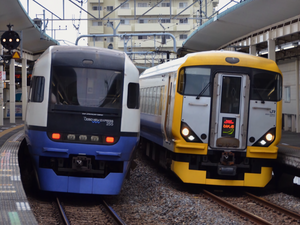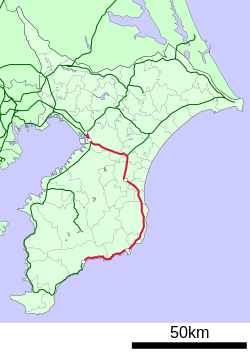Sotobō Line
This article needs additional citations for verification. (March 2011) |
| Sotobō Line | |||
|---|---|---|---|
 Sotobō Line Wakashio limited express service, November 2017 | |||
| Overview | |||
| Locale | Chiba Prefecture | ||
| Termini | |||
| Stations | 27 | ||
| Service | |||
| Type | Heavy rail | ||
| Operator(s) | JR East | ||
| Depot(s) | Chiba | ||
| History | |||
| Opened | 1896 | ||
| Technical | |||
| Line length | 93.3 km (58.0 mi) | ||
| Track gauge | 1,067 mm (3 ft 6 in) | ||
| Operating speed | 110 km/h (70 mph) | ||
| |||
Sotobo Line | ||||||||||||||||||||||||||||||||||||||||||||||||||||||||||||||||||||||||||||||||||||||||||||||||||||||||||||||||||||||||||||||||||||||||||||||||||||||||||||||||||||||||||||||||||||||||||||||||||||||||||||||||||||||||||||||||||||||||||||||||||||||||||||||||||||||||||||||||||||||||||||||||||||||||||||||||||||||||||||||||||||||||||||||||||||||||||||||||||||||||||||||||||||||||||||||||||||||||||||||||||||||||||||||||||||||||||||||||||||||||||||||||||||||||||||||||||||||||||||||||||||||||||||||||||||||||
|---|---|---|---|---|---|---|---|---|---|---|---|---|---|---|---|---|---|---|---|---|---|---|---|---|---|---|---|---|---|---|---|---|---|---|---|---|---|---|---|---|---|---|---|---|---|---|---|---|---|---|---|---|---|---|---|---|---|---|---|---|---|---|---|---|---|---|---|---|---|---|---|---|---|---|---|---|---|---|---|---|---|---|---|---|---|---|---|---|---|---|---|---|---|---|---|---|---|---|---|---|---|---|---|---|---|---|---|---|---|---|---|---|---|---|---|---|---|---|---|---|---|---|---|---|---|---|---|---|---|---|---|---|---|---|---|---|---|---|---|---|---|---|---|---|---|---|---|---|---|---|---|---|---|---|---|---|---|---|---|---|---|---|---|---|---|---|---|---|---|---|---|---|---|---|---|---|---|---|---|---|---|---|---|---|---|---|---|---|---|---|---|---|---|---|---|---|---|---|---|---|---|---|---|---|---|---|---|---|---|---|---|---|---|---|---|---|---|---|---|---|---|---|---|---|---|---|---|---|---|---|---|---|---|---|---|---|---|---|---|---|---|---|---|---|---|---|---|---|---|---|---|---|---|---|---|---|---|---|---|---|---|---|---|---|---|---|---|---|---|---|---|---|---|---|---|---|---|---|---|---|---|---|---|---|---|---|---|---|---|---|---|---|---|---|---|---|---|---|---|---|---|---|---|---|---|---|---|---|---|---|---|---|---|---|---|---|---|---|---|---|---|---|---|---|---|---|---|---|---|---|---|---|---|---|---|---|---|---|---|---|---|---|---|---|---|---|---|---|---|---|---|---|---|---|---|---|---|---|---|---|---|---|---|---|---|---|---|---|---|---|---|---|---|---|---|---|---|---|---|---|---|---|---|---|---|---|---|---|---|---|---|---|---|---|---|---|---|---|---|---|---|---|---|---|---|---|---|---|---|---|---|---|---|---|---|---|---|---|---|---|---|---|---|---|---|---|---|---|---|---|---|---|---|---|---|---|---|---|---|---|---|---|---|---|---|---|---|---|---|---|---|---|---|---|---|---|---|---|---|---|---|---|---|---|---|---|---|---|---|---|---|---|---|---|---|---|---|---|---|---|---|---|---|---|---|---|---|---|---|---|---|---|---|---|---|---|---|---|---|---|---|---|---|---|
| ||||||||||||||||||||||||||||||||||||||||||||||||||||||||||||||||||||||||||||||||||||||||||||||||||||||||||||||||||||||||||||||||||||||||||||||||||||||||||||||||||||||||||||||||||||||||||||||||||||||||||||||||||||||||||||||||||||||||||||||||||||||||||||||||||||||||||||||||||||||||||||||||||||||||||||||||||||||||||||||||||||||||||||||||||||||||||||||||||||||||||||||||||||||||||||||||||||||||||||||||||||||||||||||||||||||||||||||||||||||||||||||||||||||||||||||||||||||||||||||||||||||||||||||||||||||||
The Sotobō Line (外房線, Sotobō-sen) is a railway line in Japan operated by the East Japan Railway Company (JR East) adjacent to the Pacific Ocean, on the eastern (i.e., outer) side of the Bōsō Peninsula. It connects Chiba Station in Chiba to Awa-Kamogawa Station in Kamogawa, passing through Ōamishirasato, Mobara, Chōsei, Ichinomiya, Isumi, Onjuku, and Katsuura. The line is connected to the Uchibō Line at both ends. South of Kazusa-Ichinomiya is single track, and north of Kazusa-Ichinomiya is double track.
Services
[edit]In addition to local services, limited express and Rapid services run on this line.
- Limited Express Wakashio
- Tokyo – (Keiyō Line) – Soga – Awa-Kamogawa
- (some operate as all-stations "Local" services between Katsuura and Awa-Kamogawa
- Rapid
- Kurihama – (Yokosuka Line) – Tokyo – (Sōbu Line (Rapid)) – Soga – Kazusa-Ichinomiya
- Tokyo – (Keiyō Line) – Soga – Ōami – Kazusa-Ichinomiya (some to/from Katsuura, or Narutō on the Tōgane Line)
- Commuter Rapid services through to/from the Keiyō Line also used to operate, but they have been discontinued as of 16 March 2024.[1]
Station list
[edit]- Legend
- ● : All trains stop
- (●) : Some trains stop
- | : All trains pass
- Notes
- Local trains stop at every station.
| Station | Japanese | Distance (km) | to/from | to/from | Transfers | Location (in Chiba) | ||
|---|---|---|---|---|---|---|---|---|
| Keiyō Line Rapid | Limited express Wakashio |
Sōbu Line Rapid | Limited express Shinjuku Wakashio (Weekends only) | |||||
| Chiba | 千葉 | 0.0 | ● | ● | JO Sōbu Line (Rapid) (JO28) (some through services)
JB Chūō-Sōbu Line (JB39) Chiba Urban Monorail Line 1, Line 2 KS Keisei Chiba Line (Keisei Chiba: KS59) |
Chūō-ku, Chiba | ||
| Hon-Chiba | 本千葉 | 1.4 | ● | | | ||||
| Soga | 蘇我 | 3.8 | ● | ● | ● | ● | JE Keiyō Line (some through services) | |
| Kamatori | 鎌取 | 8.8 | ● | | | ● | | | Midori-ku, Chiba | |
| Honda | 誉田 | 12.6 | ● | | | ● | | | ||
| Toke | 土気 | 18.1 | ● | (●) | ● | | | ||
| Ōami | 大網 | 22.9 | ● | ● | ● | ● | ■ Togane Line | Ōamishirasato |
| Nagata | 永田 | 25.3 | (●) | | | | | | | ||
| Honnō | 本納 | 27.7 | (●) | | | | | | | Mobara | |
| Shin-Mobara | 新茂原 | 31.4 | (●) | | | | | | | ||
| Mobara | 茂原 | 34.3 | ● | ● | ● | ● | ||
| Yatsumi | 八積 | 38.9 | (●) | | | | | | | Chōsei | |
| Kazusa-Ichinomiya | 上総一ノ宮 | 43.0 | ● | ● | ● | ● | Ichinomiya | |
| Torami | 東浪見 | 46.2 | ● | | | | | |||
| Taitō | 太東 | 49.3 | ● | | | | | Isumi | ||
| Chōjamachi | 長者町 | 52.1 | ● | | | | | |||
| Mikado | 三門 | 53.7 | ● | | | | | |||
| Ōhara | 大原 | 57.2 | ● | ● | ● | ■ Isumi Line | ||
| Namihana | 浪花 | 60.5 | ● | | | | | |||
| Onjuku | 御宿 | 65.4 | ● | ● | ● | Onjuku | ||
| Katsuura | 勝浦 | 70.9 | ● | ● | ● | Katsuura | ||
| Ubara | 鵜原 | 74.5 | | | | | ||||
| Kazusa-Okitsu | 上総興津 | 77.2 | (●) | ● | ||||
| Namegawa-Island | 行川アイランド | 80.5 | | | | | ||||
| Awa-Kominato | 安房小湊 | 84.3 | ● | ● | Kamogawa | |||
| Awa-Amatsu | 安房天津 | 87.7 | | | | | ||||
| Awa-Kamogawa | 安房鴨川 | 93.3 | ● | ● | ■ Uchibō Line (some through services) | |||
Rolling stock
[edit]Local service
- E131 series 2-car EMUs (since 13 March 2021)
- 209-2000/2100 series 4/6-car EMUs
Keiyō Line through service
- 209-500 series 10-car EMUs
- E233-5000 series 6+4-car and 10-car EMUs
Sōbu Line (Rapid) through service
Between Chiba and Kazusa-Ichinomiya:
- E217 series 11+4-car EMUs
- E235-1000 series 11+4-car EMUs (since 21 December 2020)
Wakashio Limited Express
- 255 series EMUs
- E257-500 series EMUs
Former rolling stock
[edit]- 113 series EMUs (Sotobō Line local services, until 2011)
- 211-3000 series 5-car EMUs (Sotobō Line local services from 21 October 2006 to spring 2013)[2]
History
[edit]

The Boso Railway opened the Chiba to Oami section in 1896, extending the line to Kazusa-Ichinomiya the following year and to Ohara in 1899. The company was nationalised in 1907. The extension to Katsuura opened in 1913, to Kazusa-Okitsu in 1927, and Awa-Kamogawa in 1929.
A new tunnel and associated deviation was opened at Toke in 1954 to improve the loading gauge of the line. The Chiba to Soga section was double-tracked between 1960 and 1963, extended to Nagata between 1972 and 1974, with CTC signalling being commissioned between Soga and Awa-Kamogawa in 1974. The line to Kazusa-Ichinomiya was double-tracked between 1980 and 1986, with the Onjuku to Katsuura section double-tracked in 1995, and the Torami to Chojamachi section the following year. The entire line was electrified in 1968, and freight services ceased between 1982 and 1987.
Former connecting lines
[edit]- Mobara Station: The Mobara Town Council operated a 9 km (5.6 mi), 610 mm (2 ft) gauge handcar line to Tai Muko between 1909 and 1924. The council then decided to build a railway to connect to the Kominato Line. 12 km (7.5 mi) of 1,067 mm (3 ft 6 in) gauge line was opened as far as Okuno between 1930 and 1933, the first 6 km (3.7 mi) following the handcar line alignment. Poor patronage and economic circumstances led to the line being closed in 1939.
- Ohara Station: The Chiba Prefectural Government opened a 16 km (9.9 mi), 610 mm (2 ft) gauge handcar line to Otaki in 1912. A railcar was converted to petrol engine power in 1922. The line closed in 1927 to allow for the construction of the Isumi Line, which opened on the same alignment in 1930.
Accidents
[edit]On 8 May 2020, at 3:55 pm, the front carriage of a local service derailed between Awa-Kamogawa and Awa-Amatsu stations. Around 20 passengers and crew were on board the train (a 209 Series) when it derailed. One person was taken to a hospital.[3]
References
[edit]- ^ "京葉線で通勤快速列車の運転終了" [Commuter Rapid service on Keiyo Line ended]. Japan Railfan Magazine Online (in Japanese). Japan: Koyusha Co., Ltd. 16 March 2024. Retrieved 15 April 2024.
- ^ "10/21, 房総211系, 営業運転開始" [Boso 211 series enter service]. Japan Railfan Magazine (in Japanese). Vol. 47, no. 549. Japan: Koyusha Co., Ltd. January 2007. p. 179.
- ^ "ほぼ直線…外房線先頭車両が脱線 原因は?". headlines.yahoo.co.jp (in Japanese). 8 May 2020. Retrieved 9 May 2020.

